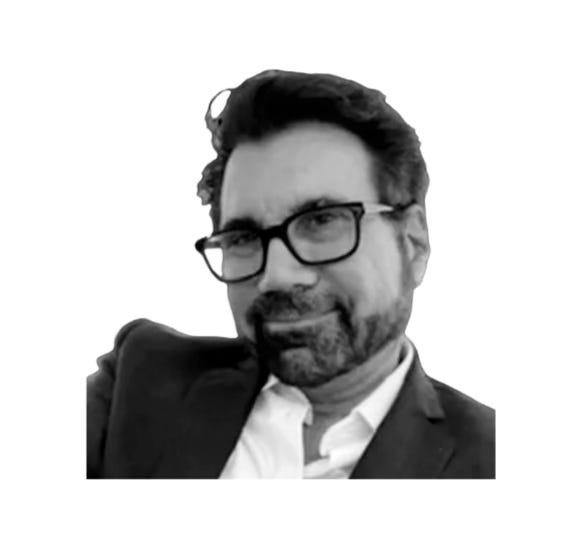Combatting Burnout: Strategies for a Healthier Workforce
Jenny Fernandez, Editor-in-Chief of Leadership, Dr. Martin Alexander Gershon, Contributing Editor in Healthcare, Endeavor Venture Funds and Partnering for BetterHealth Newsletter





Photo by Anonymous on Canva Pro
Hello! Welcome to the newsletter - “Leadership for Maximum Impact." In this weekly series, we aim to empower you with insights, strategies, and inspiration to enhance your leadership skills, enabling you to transform your professional and personal life.
The essence of growing your impact lies in our commitment to making a more meaningful and positive contribution to the people, organizations, and causes we value, fostering broader and lasting results.
Created by Jenny Fernandez, M.B.A., a Leadership and Organizational Coach, Brand Consultant, and Advisor. She is also a contributor to Harvard Business Review, Fast Company, and Forbes. Jenny helps leaders and organizations create work cultures that foster collaboration, innovation, and resilience.
I invite you to join me on this journey to design your vision, cultivate your leadership, and amplify your impact to new heights. Together, let's embark on a path of growth and empowerment.
Severe Economic Burdens from Record-Breaking Employee Job Turnover and Burnout
“Burnout is a very human problem that impacts every part of our global economy. It’s a complex combination of personal and genetic blueprint, environment, financial, emotional, and physical stressors. Fortunately the combination of science, medicine, empathy and technology are now available to reduce this pandemic burden, allowing people to be healthier and more productive.” - Dr. Martin Alexander Gershon
Burnout is one of the biggest problems affecting the workforce across all industries. In 2023, a staggering 44.5 million Americans left their jobs, down from a record-breaking 50.6 million the year before (WSJ). This high employee turnover underscores the widespread employee dissatisfaction and disengagement. According to a recent Deloitte survey, 77% of professionals have experienced burnout at their current job.
It’s fair to say that Burnout across all industries has reached pandemic levels with healthcare being the hardest hit. The economic ramifications are massive with physician and nurse burnout at an all-time high leading to chronic shortages of healthcare providers. According to a BDO survey, 71% of hospital CFOs cite physician and nursing departure from the workforce and consequent shortages as a top financial threat to hospitals.
We are past the tipping point with 50% of all healthcare professionals experiencing burnout and 22% wanting to leave the field. This problem impacts not only healthcare workers and patients but also threatens the fundamental sustainability of our hospital system.
This alarming trend places increasing pressure on managers who are not equipped with the necessary training to effectively address burnout, further perpetuating the problem.
What can we do as business leaders, health professionals and coaches to drive action plans that empower the manager and employee, support community and department interventions, and build system wide solutions?
Based on the latest science of burnout, stress and coping, interventional programs can help rejuvenate energy, drive initiative and innovation, grow leadership skills, enhance positive team building, improve social connectivity, increase efficiency and productivity, and build resilience.
The Deloitte survey highlights several critical insights: 91% of respondents stated that unmanageable stress or frustration significantly impacts the quality of their work. In addition, nearly 70% of professionals feel their employers are not doing enough to mitigate burnout, with 21% reporting that their companies do not offer any programs or initiatives to prevent or alleviate burnout.
These findings present an opportunity for employers to proactively combat burnout by fostering a more resilient workforce and addressing systemic issues that contribute to burnout. The survey emphasizes the pivotal role of workplace culture, identifying a lack of leadership support or recognition as a primary driver of burnout.
"Professionals today are undoubtedly feeling the pressure of an ‘always on’ work culture, causing stress and sometimes leading to burnout." – Deloitte Retired Managing Director Jen Fisher.
Burnout and its Root Causes - Understanding its origins
Burnout is a syndrome resulting from chronic workplace stress. Burnout is a problem that is almost always systemic and endemic to the workplace rather than reflecting a problem with individual employees.
Burnout expert and UC Berkeley Psychology Professor Christina Maslach has identified six areas that produce burnout:
Unsustainable workload
Perceived lack of control
Insufficient rewards for effort
Lack of a supportive community
Lack of fairness
Mismatched values and skills
Burnout is frequently misunderstood and sometimes dismissed as either exaggeration or a lack of resilience. However, it is crucial for leaders to recognize the seriousness of burnout concerns. Ignoring or misunderstanding burnout can result in disengagement, reduced productivity, and ultimately, increased attrition rates among employees.
The primary root causes of burnout include excessive workload, difficult workplace relationships, and a lack of autonomy. Employees overwhelmed by their workload often struggle to maintain a healthy work-life balance, leading to chronic stress and burnout. Additionally, challenging relationships with colleagues or supervisors can create a toxic work environment that exacerbates feelings of stress and frustration. Finally, a lack of autonomy in one's role can leave employees feeling powerless and undervalued, further contributing to burnout.
Potential Solutions - Addressing Burnout: Solutions for Individuals, Departments, and Systems
For Individuals
Burnout is a pressing issue affecting healthcare professionals across all functions, and talking it requires a nuanced approach that prioritizes personal well-being, resilience, and professional growth. Consider the case of Dr. Amanda (last name withheld), an emergency room physician at a major urban hospital during the peak of the COVID-19 pandemic. The surge in patient numbers and the severe cases she encountered daily added immense stress to her already demanding job. The "unrelenting hustle" to save lives led her to neglect her own health, resulting in chronic fatigue and emotional exhaustion. Amanda began to lose perspective, doubting her abilities as a doctor and struggling with feelings of helplessness despite her dedication and hard work.
Another case we encountered is that of Dr. Sarah (not her real name), a senior surgeon at a prestigious medical center, faced a similar burnout scenario. After taking on multiple complex surgeries and leadership roles within the hospital, she found herself constantly working long hours, often extending into nights and weekends. The continuous demands of her role, combined with the pressure to maintain high performance, led to severe burnout. Sarah felt like her body was running on adrenaline, trying to perform at a high level all the time, but she couldn't mentally step back from work. The stress became overwhelming, affecting her mental and physical health, and she began to question her career choices.
Another healthcare professional, whom we'll call Dr. James, struggled as the head of a community health clinic in a low-income neighborhood. The relentless need to address the numerous health disparities and the limited resources available created a toxic work environment. The internal dynamics and the mismatch between his values and the bureaucratic demands of the healthcare system eroded his sense of self and purpose. James felt trapped in his role, unable to reconcile his passion for community health with the overwhelming stress and lack of support, leading to significant burnout and a loss of direction.
Over the past 20 years as a coach, people manager, and educator, I've helped thousands of clients, students, and executive-development program participants in similar predicaments learn to manage the stress that can cause burnout and to ultimately achieve more sustainable career success. The process involves noticing and acknowledging the symptoms, examining the underlying causes, and developing preventive strategies to counteract your particular pattern of burnout.
“If there is a silver lining, it’s an increased awareness of and open dialogue about mental health and the importance of investing in well-being” - McKinsey partner Erica Coe.
By seeking help, working with a coach and attending resilience workshops, they began to combat burnout.
They learned to prioritize self-care by learning to set boundaries, saying no to excessive demands, and focusing on tasks that aligned with their values.
Improving their time management by delegating tasks and taking regular breaks helped them maintain a healthier work-life balance.
Learning to reframe challenges and focus on what was important and within their control allowed them to manage stress more effectively.
Seeking support and connections from mentors and peer support groups provided them with guidance and a sense of community.
In addition to these health-focused strategies, fostering a sense of purpose and fulfillment is essential. Continuous learning opportunities and career development can reinvigorate a sense of passion and commitment to the profession. Matching personal values with professional roles can enhance job satisfaction and motivation, making work more meaningful.
For instance, healthcare workers can pursue resilience and adaptability masterclasses, specialized training in areas they are passionate about or take on roles that align with their values, such as patient advocacy or community health initiatives. By integrating these elements, healthcare workers can develop the skills and resilience needed to thrive in their demanding roles, ultimately reducing burnout and enhancing the quality of care they provide.
One notable fact to highlight is that while everyone has the potential to experience burnout, there are gender differences that must be acknowledged. McKinsey’s annual Women in the Workplace report highlights a concerning trend, women are reporting burnout symptoms at significantly higher rates than men. The 2022 report reveals that the burnout gap between women and men has nearly doubled compared to the previous year with 42% of women feeling burned out. Be in the lookout for a future newsletter on this topic!
For Community
Addressing burnout at the community level, such as within departments, involves creating an environment where healthcare workers feel supported and valued. One critical strategy is increasing staffing for overburdened teams, ensuring that workloads are manageable and that employees have sufficient time to provide high-quality care without feeling overwhelmed.
Departments can also provide coaching for people leaders to improve team resiliency, fostering a collaborative and supportive work environment. Implementing comprehensive wellness programs that address both physical and mental health can further support staff well-being. These programs might include mental health workshops, and counseling and coaching services. By prioritizing these initiatives, departments can create a foundation for a healthier and more resilient workforce.
Creating a non-toxic work culture is also paramount in addressing burnout at the community level. This involves promoting open communication, mutual respect, and a culture where everyone feels safe to seek help when needed. For example, in one case study, a senior partner with caregiving responsibilities received additional staffing support and leadership coaching to help manage his workload and stress. This not only alleviated his personal burden but also set a precedent for the kind of supportive and responsive culture the department aimed to cultivate. By addressing systemic issues and fostering a positive work environment, departments can significantly reduce burnout and enhance overall job satisfaction and performance among healthcare workers.
For Systems
Dr. Elyse R. Park, Clinical Health Psychologist at Mass General Brigham and Harvard Medical School, speaks about the Individual, Clinical, and System-level perspective through her work at Mass General Hospital and Harvard Medica School.
Next Steps - Moving Forward: Building a Resilient Workforce
Burnout is a pervasive issue affecting both employees and leaders. By understanding the root causes and implementing targeted solutions, leaders can create a healthier work environment. Ongoing monitoring and support are essential for sustaining positive change and retaining talent.
What Can You Do at Your Company Right Now?
The first step is Assessment. The Endeavor team is working on a Burnout Assessment Index using the following criteria.
Burnout Assessment
To find out if you might have job burnout, answer these Burnout Assessment Questions:
Emotional and Mental Well-being:
Do you question the value of your work?
Do you feel little satisfaction from what you get done?
Do you feel let down by your job?
Do you doubt your skills and abilities?
Do you think that nothing you do at work makes a difference?
Do you feel frustrated, disappointed, or disillusioned with work?
Physical and Emotional Exhaustion:
Does your work leave you feeling exhausted?
Do you lack the energy to do your job well?
Are you neglecting yourself (e.g., not taking time to rest, eat, or exercise)?
Work Engagement and Motivation:
Do you drag yourself to work and have trouble getting started?
Is it hard to focus on your job?
Have you lost the enthusiasm you had for your job?
Interpersonal Relationships at Work:
Do you feel removed from your work and the people you work with?
Have you lost patience with co-workers, customers, or clients?
Do you appear uncaring, disinterested, or insensitive at work?
Have you started caring less about your colleagues?
Have your family, friends, or colleagues noticed a change in your character?
Coping Mechanisms and Behavioral Changes:
Are you using food, drugs, or alcohol to feel better or to numb how you feel?
Have your sleep habits changed?
According to the Mayo Clinic, if you answered yes to any of these questions, you might have job burnout. Understanding these indicators is crucial for leaders to provide appropriate support and interventions.
Addressing burnout requires a comprehensive and sustained effort. Leaders equipped with the right tools and strategies can foster a resilient and engaged workforce.
Masterclass Series on Burnout
Are you interested in learning more about Endeavor’s Masterclasses?
If you found this article insightful and would like more information about the Endeavor’s Masterclass Series as part of our Educational Series of Masterclasses and Workshops on Burnout, please contact us at masterclass@gershoncapital.com
The Leadership Team at Endeavor offers 90 min - ½ day interactive sessions over a series of several weeks that can help senior managers address the problem of burnout in their teams.
Who Should Enroll in Burnout Masterclasses?
Chief Medical Officers, Department Heads, and Healthcare Professionals.
Assessing the State of Your Workforce and Environment
Identifying the Root Causes of Burnout
Managing Burnout Symptoms at
Individual
Community
Systems Levels
Empowering Employees to Problem-Solve
Creating a Resilient Workforce and GROUP Culture
Implementing Innovative System Solutions
Leveraging Digital Innovation Partners for Sustainable Solutions
About the Editor-in-Chief
Jenny Fernandez is the Director of Leadership at Endeavor Venture Studio working with CEO/Founders in emerging, and high-growth companies. She is a recognized Leadership and Branding Coach helping to drive accelerated and transformative growth through Strategic Positioning, Partnerships and Innovative Thinking. Jenny has been named by LinkedIn “Top Voice and was honored to join Marshall Goldsmith’s 100 Coaches community, a recognition given to the world’s top leadership and executive coaches and thought leaders. She is a contributing author at Harvard Business Review, Forbes, and Fast Company. She trained at Kellogg School of Management, where she received her MBA. She is currently a professor at Columbia Business and New York University, teaching Next Gen leaders in Leadership, Branding and Marketing.
About the Contributing Editor
Dr. Martin Alexander Gershon, Managing Partner & Chief Strategy Officer, Endeavor; Editor-in-Chief, Endeavor Partnering for BetterHealth Newsletter
Dr. Martin Alexander Gershon, MD, JD, MPH is the Managing Partner and Chief Strategy Officer of Endeavor Ventures and Endeavor Strategy Consulting Group, Advisor to Fortune 500 Companies and the White House Moonshot CancerX Accelerator Program, and recognized by Linkedin as a “Top Voice” in Venture Capital and Entrepreneurship.
He has been honored by S&P as a designated Top 100 “Healthcare Industry Leader”, and has been featured on CNBC and in numerous conferences and publications as one of the leading healthcare investors, strategists, and futurists in the commercialization of healthcare innovation, always “skating to where the puck is going, not where it is.”
Dr. Gershon is the architect of Endeavor's thriving ecosystem of partnerships and thought leaders that comprise the Endeavor Strategy Consulting Group. This advisory group’s strength is in using real world experience to make prescient, future facing investments and advising clients about how to prepare now for the future ahead.
Over the past 24 years, he has served as Senior Strategic Advisor for McKinsey, Goldman Sachs, Bain Capital, BlackRock, American Express, Tiger Global, GlaxoSmithKline, Bristol-Myers Squibb, Pfizer, Novartis, and the Federal Reserve Board of Governors.
What's Next? Stay tuned for upcoming episodes where we'll go deeper into leadership principles, success stories, and actionable insights to scale your leadership and fuel your professional growth. Feel free to share your thoughts, experiences, or topics you'd like us to cover in future newsletters. Let's embark on this journey of growth together!
Remember, the path to leadership is a continuous journey. Let's make 2024 a year of immense growth, success, and positive impact.
Here are some ways to access further strategies, tips, and resources:
★ Follow me on LinkedIn to join the conversation on my posts on #leadership#collaboration#innovation and #branding topics. Feel free to share the newsletter with friends and colleagues who could benefit from these insights by forwarding it.
★ And if you love YouTube or Instagram, feel free to follow me. I will be sure to post videos, stories, and photos on Leadership Hacks!
★ Follow my Business Website for my blog, tips, and special content.
★ Reach out to me directly at jenny@jennyfernandez.com
Make sure you never miss an issue by clicking the "Subscribe" button. For more articles, tips, and insights, connect with me here!








